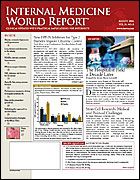NSAIDs, Steroids Promote Hypertension, Compromise BP Control
NEW YORK CITY?Nonsteroidal antiinflammatory drugs (NSAIDs) and steroids are the main culprits in drug-induced high blood pressure (BP), said William J. Elliott, MD, PhD, professor of preventive medicine, internal medicine, and pharmacology, Rush University, Chicago, at the 21st Annual Scientific Meeting of the American Society of Hypertension.
"NSAIDs probably affect the blood pressure of the largest number of people in the United States, because they're so ubiquitous," he said. "Lots of people use high doses over the counter."
Patients often take nonprescription doses of NSAIDs that are equivalent to prescription strength without telling their physicians, he said, which interferes with their BP control. The sodium found in most NSAIDs is part of the problem.
The drug interactions that occur with NSAIDs and antihypertensive drugs affect BP control. The interaction is greatest between angiotensin-converting-enzyme (ACE) inhibitors and angiotensin receptor blockers (ARBs) and least between calcium antagonists and alpha blockers.
ACE inhibitors/ARBs and NSAIDs can act synergistically to compromise renal function.
Afferent blood flow to the glomerulus is aided by vasodilation mediated through prostaglandins. The use of NSAIDs, including cyclooxygenase (COX)-2 selective inhibitors, can inhibit this vasodilation, resulting in compromised blood supply to the glomerulus. And since the efferent blood flow from the glomerulus is controlled by angiotensin II, ACE inhibitors and ARBs can reduce glomerular pressure and filtration.
The use of ACE inhibitors or ARBs in combination with NSAIDs can cause loss of hemostatic control in the glomerulus, resulting in nephrotoxicity.
"There's a misperception that COX-2 inhibitors are not a problem," said Dr Elliott. More studies are needed in this area, he said, but the available data show that celecoxib (Celebrex), the only COX-2 inhibitor currently on the market, affects BP less than rofecoxib (Vioxx) did. However, he added, since many of the celecoxib?rofecoxib comparison studies were funded by the manufacturers of celecoxib, their results should be interpreted with caution.
In one study, celecoxib was significantly less likely than rofecoxib to increase systolic BP by ≥20 mm Hg in older hypertensive patients who had osteoarthritis.
Another study showed that additional BP medications or an increase in antihypertensive drug dose was required more often in rofecoxib than in celecoxib recipients.
Other studies have shown a greater risk of myocardial infarction and a 3-fold greater likelihood of being hospitalized for hypertension with rofecoxib than with celecoxib.
Corticosteroids may be responsible for the greatest proportion of patients who end up with poor BP control, said Dr Elliott. They can cause sodium and water retention and hypocalcemia, which increase BP. Corticosteroids also raise the level of renin substrate and reduce the activity of various vaso-depressor mechanisms to potentiate hypertension.
"Exactly why corticosteroids raise blood pressure is one of those complicated things; it's not well sorted out," he said. "Some say that it's because of 11 beta-hydroxysteroid dehydrogenase inhibition that occurs when cortisol or other corticosteroids are present and floating around in the blood." Isoforms of human 11 beta-hydroxysteroid dehydrogenase play a crucial role in modulating glucocorticoid and mineralocorticoid hormone action.
No specific antidote to cortico-steroid-induced hypertension exists; diuretics and ACE inhibitors are the drugs used most often to treat it.
Estrogenic steroids can also increase BP, but the low doses of steroids used in today's oral contraceptives (OC) rarely pose a risk. Most physicians who prescribe OCs are vigilant about monitoring BP after about 3 months and stop the OC if BP escalates. Stopping the contraceptive use returns BP to baseline. eroids used in today's oral contraceptives (OC) rarely pose a risk. Most physicians who prescribe OCs are vigilant about monitoring BP after about 3 months and stop the OC if BP escalates. Stopping the contraceptive use returns BP to baseline.
FDA Allows Barley Products to List CHD Reduction Claim
The FDA now allows makers of foods containing barley to claim that these foods can reduce the risk of coronary heart disease (CHD). Specifically, whole-grain barley and dry-milled barley products, such as flakes, grits, flour, and pearled barley, which provide at least 0.75 g/serving of soluble fiber, may bear such a claim.
